Portal:New South Wales
Portal maintenance status: (June 2018)
|
The New South Wales Portal
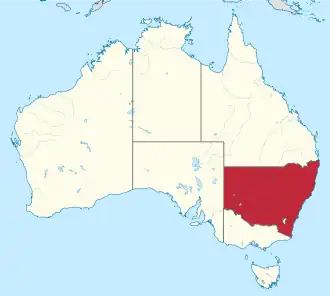
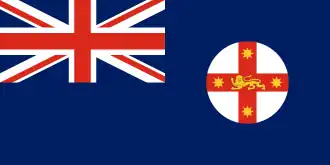
New South Wales (commonly abbreviated as NSW) is a state on the east coast of Australia. It borders Queensland to the north, Victoria to the south, and South Australia to the west. Its coast borders the Coral and Tasman Seas to the east. The Australian Capital Territory and Jervis Bay Territory are enclaves within the state. New South Wales' state capital is Sydney, which is also Australia's most populous city. In December 2024, the population of New South Wales was over 8.5 million, making it Australia's most populous state. Almost two-thirds of the state's population, 5.3 million, live in the Greater Sydney area.
The Colony of New South Wales was founded as a British penal colony in 1788. It originally comprised more than half of the Australian mainland with its western boundary set at 129th meridian east in 1825. The colony then also included the island territories of Van Diemen's Land, Lord Howe Island, and Norfolk Island. During the 19th century, most of the colony's area was detached to form separate British colonies that eventually became the various states and territories of Australia. The Swan River Colony (later called the Colony of Western Australia) was never administered as part of New South Wales. (Full article...)
 Recognized content -
Recognized content - 
-
 Image 1
Image 1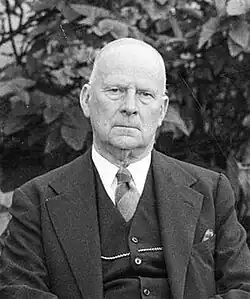 Bruxner in 1951
Bruxner in 1951
Lieutenant Colonel Sir Michael Frederick Bruxner KBE, DSO, JP (25 March 1882 – 28 March 1970) was an Australian politician and soldier, serving for many years as leader of the Country Party (and its predecessors) in New South Wales. Born in the north of the state, Bruxner was educated at The Armidale School and started studies at University of Sydney but later dropped out to take up employment as a grazier and station agent in Tenterfield. After serving in the Citizen Military Forces from 1911, Bruxner enlisted into the Australian Light Horse upon the outbreak of the First World War in 1914. Serving with distinction in Gallipoli, Egypt and Palestine, he was promoted to lieutenant colonel and awarded the Distinguished Service Order.
Returning to Australia in 1919, Bruxner sold his business and joined the Progressive Party, being elected to the Parliament of New South Wales for Northern Tablelands at the 1920 election. Bruxner came to political prominence when he led the rural "True Blues" faction of the Progressive Party that went against their Leader's decision to form a coalition in Sir George Fuller's short-lived government in 1921. Bruxner emerged as the leader of the reduced Progressive Party, which consisted of the members of his faction, but they nevertheless joined with Fuller's Nationalists to form government in 1922. Bruxner also became involved in the New England New State Movement. Bruxner resigned the party leadership, now for the renamed Country Party, at the end of 1925. (Full article...) -
 Image 2
Image 2
Aleeta is a genus of cicadas with the only species Aleeta curvicosta (commonly known as the floury baker or floury miller, known until 2003 as Abricta curvicosta), one of Australia's most familiar insects. Native to the continent's eastern coastline, it was described in 1834 by Ernst Friedrich Germar.
The floury baker's distinctive appearance and loud call make it popular with children. Both the common and genus name are derived from the white, flour-like filaments covering the adult body. Its body and eyes are generally brown with pale patterns including a light-coloured line along the midline of the pronotum. Its forewings have distinctive dark brown patches at the base of two of their apical cells. The female is larger than the male, although species size overall varies geographically, with larger animals associated with regions of higher rainfall. The male has distinctive genitalia and a loud and complex call generated by the frequent buckling of ribbed tymbals and amplified by abdominal air sacs. (Full article...) -
 Image 3
Image 3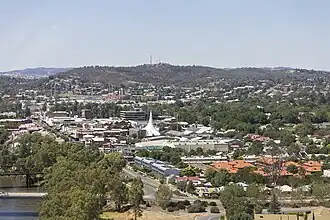 Wagga Wagga City Centre
Wagga Wagga City Centre
Wagga Wagga (/ˌwɒɡə ˈwɒɡə/; informally called Wagga) is a major regional city in the Riverina region of New South Wales, Australia. Straddling the Murrumbidgee River, with an urban population of more than 57,003 as of 2021, it is an important agricultural, military, and transport hub of Australia. The ninth largest inland city in Australia, Wagga Wagga is located midway between the two largest cities in Australia—Sydney and Melbourne—and is the major regional centre for the Riverina and South West Slopes regions.
The central business district is focused around the commercial and recreational grid bounded by Best and Tarcutta Streets and the Murrumbidgee River and the Sturt Highway. The main shopping street of Wagga is Baylis Street which becomes Fitzmaurice Street at the northern end. Wagga is accessible from Sydney via the Sturt and Hume Highways, Adelaide via the Sturt Highway and Albury and Melbourne via the Olympic Highway and Hume Highway. Wagga is in an alluvial valley and much of the city has a problem with urban salinity. (Full article...) -
 Image 4
Image 4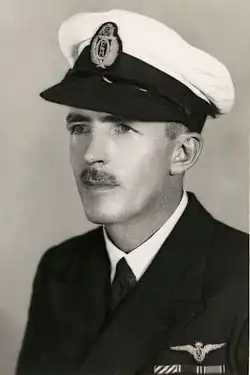 Qantas Captain Lester Brain in the 1930s
Qantas Captain Lester Brain in the 1930s
Lester Joseph Brain, AO, AFC (27 February 1903 – 30 June 1980) was a pioneer Australian aviator and airline executive. Born in New South Wales, he trained with the Royal Australian Air Force (RAAF) before joining Queensland and Northern Territory Aerial Services (Qantas) as a pilot in 1924. He was awarded the Air Force Cross in 1929, after locating the lost aircraft Kookaburra in northern Australia. Having risen to Chief Pilot at Qantas by 1930, he was appointed Flying Operations Manager in 1938. As a member of the RAAF reserve, Brain coordinated his airline's support for the Australian military during World War II. He earned a King's Commendation for his rescue efforts during an air raid on Broome, Western Australia, in 1942, and was promoted to wing commander in 1944.
Seeing little prospect for advancement at Qantas once the war had ended, Brain left to join the fledgling government-owned domestic carrier Trans Australia Airlines (TAA) in June 1946. Appointed its first General Manager, he swiftly built up the organisation to the stage where it could commence scheduled operations later in the year. By the time he resigned in March 1955, TAA was firmly established as one half of the Commonwealth government's two-airline system. After his departure from TAA, Brain became Managing Director of de Havilland Aircraft in Sydney, before joining the board of East-West Airlines as a consultant in January 1961. He was appointed an Officer of the Order of Australia in January 1979 and died in June the following year, aged seventy-seven. (Full article...) -
 Image 5
Image 5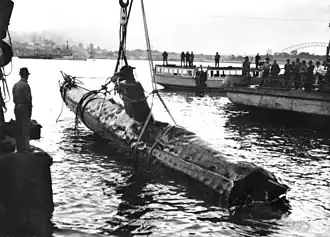 A Japanese Ko-hyoteki class midget submarine, believed to be midget No. 14, is raised from Sydney Harbour the day after the attack.
A Japanese Ko-hyoteki class midget submarine, believed to be midget No. 14, is raised from Sydney Harbour the day after the attack.
From 31 May to 8 June 1942, during World War II, Imperial Japanese Navy submarines made a series of attacks on the Australian cities of Sydney and Newcastle. On the night of 31 May – 1 June, three Ko-hyoteki-class midget submarines (M-14, M-21 and M-24), each with a two-member crew, entered Sydney Harbour, avoided the partially constructed Sydney Harbour anti-submarine boom net, and attempted to sink Allied warships. Two of the midget submarines were detected and attacked before they could engage any Allied vessels. The crew of M-14 scuttled their submarine, whilst M-21 was successfully attacked and sunk. The crew of M-21 committed suicide. These submarines were later recovered by the Allies. The third submarine attempted to torpedo the heavy cruiser USS Chicago, but instead sank the converted ferry HMAS Kuttabul, killing 21 sailors. This midget submarine's fate was unknown until 2006, when amateur scuba divers discovered the wreck off Sydney's northern beaches.
Immediately following the raid, the five Japanese fleet submarines that carried the midget submarines to Australia embarked on a campaign to disrupt merchant shipping in eastern Australian waters. Over the next month, the submarines attacked at least seven merchant vessels, sinking three ships and killing 50 sailors. During this period, between midnight and 02:30 on 8 June, two of the submarines bombarded the ports of Sydney and Newcastle. (Full article...) -
 Image 6
Image 6 Charles Green at Wewak, New Guinea, in September 1945
Charles Green at Wewak, New Guinea, in September 1945
Charles Hercules Green DSO (26 December 1919 – 1 November 1950) was an Australian military officer who was the youngest Australian Army infantry battalion commander during World War II. He went on to command the 3rd Battalion, Royal Australian Regiment (3 RAR), during the Korean War, where he died of wounds. He remains the only commanding officer of a Royal Australian Regiment battalion to die on active service. Green joined the part-time Militia in 1936, and before the outbreak of World War II had been commissioned as a lieutenant. He volunteered for overseas service soon after the war began in September 1939, and served in the Middle East and the Battle of Greece with the 2/2nd Battalion. After the action at Pineios Gorge on 18 April 1941, Green became separated from the main body of the battalion, and made his way through Turkey to Palestine, to rejoin the reformed 2/2nd Battalion. The 2/2nd Battalion returned to Australia in August 1942 via Ceylon (modern Sri Lanka), to meet the threat posed by the Japanese.
Green performed instructional duties and attended courses until July 1943 when he rejoined the 2/2nd Battalion as its second-in-command. At the time, the unit was training in Queensland. From March to July 1945, Green commanded the 2/11th Battalion during the Aitape-Wewak campaign in New Guinea. For his performance during the campaign, Green was appointed a Companion of the Distinguished Service Order. After the war, Green briefly returned to civilian life and part-time military service as commanding officer of the 41st Battalion. When the Regular Army was formed, Green returned to full-time service in early 1949. (Full article...) -
 Image 7Keith Ormond Edley Johnson MBE (28 December 1894 – 19 October 1972), was an Australian cricket administrator. He was the manager of the Australian Services cricket team in England, India and Australia immediately after World War II, and of the Australian team that toured England in 1948. The 1948 Australian cricket team earned the sobriquet The Invincibles by being the first side to complete a tour of England without losing a single match.
Image 7Keith Ormond Edley Johnson MBE (28 December 1894 – 19 October 1972), was an Australian cricket administrator. He was the manager of the Australian Services cricket team in England, India and Australia immediately after World War II, and of the Australian team that toured England in 1948. The 1948 Australian cricket team earned the sobriquet The Invincibles by being the first side to complete a tour of England without losing a single match.
Johnson joined the Australian Board of Control for International Cricket in 1935 as a delegate for New South Wales and served in the Royal Australian Air Force during World War II, performing public relations work in London. With the allied victory in Europe, first-class cricket resumed and Johnson was appointed to manage the Australian Services team, which played England in a series of celebratory matches known as the Victory Tests to usher in the post-war era. The series was highly successful, with unprecedented crowds raising large amounts for war charities. As a result, further matches were scheduled and Johnson's men toured British India and Australia before being demobilised. Johnson's administration was regarded as a major factor in the success of the tour. (Full article...) -
 Image 8
Image 8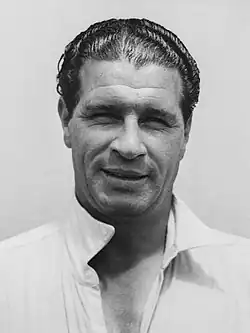 Toshack c. 1947
Toshack c. 1947
Ernest Raymond Herbert Toshack (8 December 1914 – 11 May 2003) was an Australian cricketer who played in 12 Tests from 1946 to 1948. A left arm medium paced bowler known for his accuracy and stamina in the application of leg theory, Toshack was a member of Don Bradman's "Invincibles" that toured England in 1948 without being defeated. Toshack reinforced the Australian new ball attack of Ray Lindwall and Keith Miller.
Born in 1914, Toshack overcame many obstacles to reach international level cricket. He was orphaned as an infant, and his early cricket career was hindered because of financial difficulties caused by the Great Depression. The Second World War prevented Toshack from competing at first-class level until he was into his thirties. In 1945–46, the first season of cricket after the end of the War, Toshack made his debut at first-class level and after only seven matches in the Sheffield Shield he was selected for Australia's tour of New Zealand. In Wellington, he opened the bowling in a match that was retrospectively classed as an official Test match. Toshack became a regular member of the Australian team, playing in all of its Tests until the 1947–48 series against India. He took his career-best match bowling figures of 11 wickets for 31 runs (11/31) in the First Test but began to suffer recurring knee injuries, and a medical board had to approve his selection for the 1948 England tour. Toshack played in the first four Tests before being injured. After a long convalescence, he attempted a comeback during Australia's 1949–50 season, but further injury forced him to retire. He was a parsimonious bowler, who was popular with crowds for his sense of humour. (Full article...) -
 Image 9
Image 9.jpg) Flowers emerging from base of cone
Flowers emerging from base of cone
Isopogon anethifolius, commonly known as narrow-leaf drumsticks or narrow-leafed drumsticks, is a shrub in the family Proteaceae. The species is found only in coastal areas near Sydney in New South Wales, and to the immediate west. It occurs naturally in woodland, open forest and heathland on sandstone soils. An upright shrub, it can reach to 3 m (9.8 ft) in height, with terete leaves that are divided and narrow. The yellow flowers appear in the Spring, from September to December, and are prominently displayed. They are followed by round grey cones, which give the plant its common name of drumsticks. The small hairy seeds are found in the old flower parts.
Isopogon anethifolius regenerates after bushfire by resprouting from its woody base, known as a lignotuber, as well as from seed. It was described by Richard Salisbury in 1796, and was first grown in the United Kingdom the same year. One of the easiest members of the genus Isopogon to grow in cultivation, I. anethifolius grows readily in the garden if located in a sunny or part-shaded spot with sandy soil and good drainage. (Full article...) -
 Image 10The murder of Leigh Leigh, born Leigh Rennea Mears, occurred on 3 November 1989 while she was attending a 16-year-old boy's birthday party at Stockton Beach, New South Wales, on the east coast of Australia. The 14-year-old girl from Fern Bay was assaulted by a group of boys after she returned distressed from a sexual encounter on the beach that a reviewing judge later called non-consensual. After being kicked and spat on by the group, Leigh left the party. Her naked body was found in the sand dunes nearby the following morning, with severe genital damage and a crushed skull.
Image 10The murder of Leigh Leigh, born Leigh Rennea Mears, occurred on 3 November 1989 while she was attending a 16-year-old boy's birthday party at Stockton Beach, New South Wales, on the east coast of Australia. The 14-year-old girl from Fern Bay was assaulted by a group of boys after she returned distressed from a sexual encounter on the beach that a reviewing judge later called non-consensual. After being kicked and spat on by the group, Leigh left the party. Her naked body was found in the sand dunes nearby the following morning, with severe genital damage and a crushed skull.
Matthew Grant Webster, an 18-year-old who acted as a bouncer at the event, pleaded guilty to her murder and was sentenced to 20 years in prison with a 14-year non-parole period. He was released on parole in June 2004, after serving 14½ years. Guy Charles Wilson, the other bouncer and only other person aged over 18 at the party, pleaded guilty to assault; a third male (aged 15) pleaded guilty to having sex with a minor. The investigation of Leigh's murder proved controversial, however, as several people who admitted to various crimes, including assaulting Leigh, were never charged; nor was anyone ever charged with her sexual assault. Webster's confession did not match the forensic evidence. The murder investigation was reviewed by the New South Wales Crime Commission in 1996, and by the Police Integrity Commission in 1998, with the latter recommending the dismissal of the detective in charge of the investigation. (Full article...) -
 Image 11HMCS Integrity was a cutter built by the Colonial Government of New South Wales in 1804. She was the first vessel ever launched from a New South Wales dockyard and carried goods between the colony's coastal settlements of Norfolk Island, Newcastle, New South Wales, Van Diemen's Land and Port Jackson. In 1804 she took part in a series of voyages to Van Diemen's Land with the aim of founding a colony at Port Dalrymple, the site of the modern settlement of George Town, Tasmania.
Image 11HMCS Integrity was a cutter built by the Colonial Government of New South Wales in 1804. She was the first vessel ever launched from a New South Wales dockyard and carried goods between the colony's coastal settlements of Norfolk Island, Newcastle, New South Wales, Van Diemen's Land and Port Jackson. In 1804 she took part in a series of voyages to Van Diemen's Land with the aim of founding a colony at Port Dalrymple, the site of the modern settlement of George Town, Tasmania.
In 1805 Integrity encountered and recaptured a Spanish brig which had been unlawfully seized by privateers and concealed in the Kent Group of islands in Bass Strait. Having returned the Spanish vessel to colonial control, Integrity was designated the task of sailing to Chile to negotiate its return to Spain. She set sail for Valparaíso, Chile, in June 1805, but was not seen again and is likely to have foundered during the voyage. (Full article...) -
 Image 12
Image 12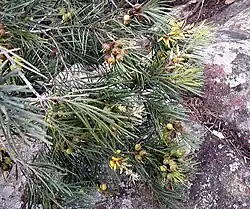
Persoonia linearis, commonly known as the narrow-leaved geebung, is a shrub native to New South Wales and Victoria in eastern Australia. It reaches 3 m (9.8 ft), or occasionally 5 m (16 ft), in height and has thick, dark grey papery bark. The leaves are, as the species name suggests, more or less linear in shape, and are up to 9 cm (3.5 in) long, and 0.1 to 0.7 cm (0.039 to 0.276 in) wide. The small yellow flowers appear in summer, autumn and early winter (December to July), followed by small green fleshy fruit known as drupes. Within the genus Persoonia, it is a member of the Lanceolata group of 58 closely related species. P. linearis interbreeds with several other species where they grow together.
Found in dry sclerophyll forest on sandstone-based nutrient-deficient soils, P. linearis is adapted to a fire-prone environment; the plants resprout epicormic buds from beneath their thick bark after bushfires. The fruit are consumed by vertebrates such as kangaroo, possums and currawongs. As with other members of the genus, P. linearis is rare in cultivation as it is very hard to propagate by seed or by cuttings, but once propagated, it adapts readily, preferring acidic soils with good drainage and at least a partly sunny aspect. (Full article...) -
 Image 13
Image 13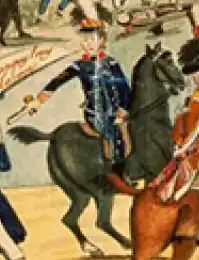 1804 depiction of a trooper of the Guard
1804 depiction of a trooper of the Guard
The Governor's Body Guard of Light Horse was a military unit maintained in the Colony of New South Wales between 1801 and 1834, and reputedly the "first full-time military unit raised in Australia". It was established by Governor Philip Gidley King by drawing men from the New South Wales Corps, the British garrison in the colony. Normally consisting of one or two non-commissioned officers and six privates, the Guard provided an escort to the governor and carried his despatches to outposts across the colony. From 1802, the men of the Guard were drawn from convicts pardoned by King. Men from the unit were deployed during the Castle Hill convict rebellion of 1804 and a trooper of the Guard assisted in the capture of two of the rebel leaders.
After King was succeeded by William Bligh in 1806, the Guard reverted to being drawn from the New South Wales Corps. The unit seems to have been absent during the Corps' 1808 mutiny against Bligh and, by one report, supported it. It was ordered to disband by the Earl of Liverpool but was granted a reprieve in 1812 by Liverpool's successor Earl Bathurst. Viscount Goderich ordered disbandment again in 1832 and Governor Richard Bourke transformed the unit into the Mounted Orderlies in 1834. These were absorbed into the New South Wales Mounted Police in 1836 and continued as a separate component within that force until at least 1860. (Full article...) -
 Image 14
Image 14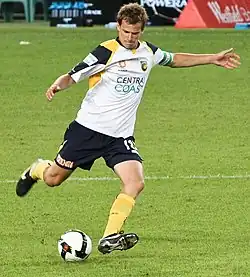
Alex Wilkinson was club captain from 2007 to 2012.
Central Coast Mariners Football Club is an Australian professional association football club based in Gosford, on the Central Coast of New South Wales. The club was formed in November 2004, and the team played their first competitive match in May 2005, when they entered the 2005 Australian Club World Championship Qualifying Tournament. The Mariners play their home matches at Central Coast Stadium. 181 players have made a competitive first-team appearance for the club; those players are listed here. Players are listed in order of their first appearance for the Mariners, and alphabetical order by surname for players who debuted simultaneously.
The Mariners' record appearance-maker is John Hutchinson, who made 271 appearances over a 10-year playing career, ahead of Matt Simon. Hutchinson also holds the record for the most starts, having started in 232 games. Simon is the club's top goalscorer with 66 goals in his eleven seasons with the club, twenty-three more than next-highest scorer Adam Kwasnik. Nineteen players have made 100 appearances or more, including six members of the 2013 A-League Grand Final winning team and three members of the 2023 A-League Men Grand Final and 2024 A-League Men Grand Final winning teams. Danny Vukovic is the only goalkeeper to have made over 100 appearances for the side. Eight players have held the position of club captain, Alex Wilkinson for the longest period (five years). (Full article...) -
 Image 15
Image 15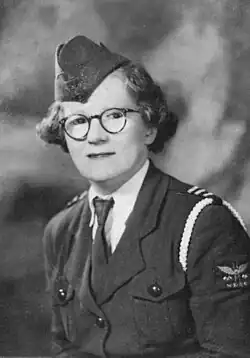 McKenzie in uniform c. 1940
McKenzie in uniform c. 1940
Florence Violet McKenzie OBE (née Granville; 28 September 1890 – 23 May 1982), affectionately known as "Mrs Mac", was Australia's first female electrical engineer, founder of the Women's Emergency Signalling Corps (WESC) and lifelong promoter for technical education for women. She campaigned successfully to have some of her female trainees accepted into the all-male Navy, thereby originating the Women's Royal Australian Naval Service (WRANS). Some 12,000 servicemen passed through her signal instruction school in Sydney, acquiring skill in Morse code and visual signalling (flag semaphore and International Code of Signals).
She set up her own electrical contracting business in 1918, and apprenticed herself to it, in order to meet the requirements of the Diploma in Electrical Engineering at Sydney Technical College. Described at the time as Australia's "Mademoiselle Edison", in 1922 she became the first Australian woman to take out an amateur radio operator's licence. Through the 1920s and 1930s, her "Wireless Shop" in Sydney's Royal Arcade was renowned amongst Sydney radio experimenters and hobbyists. She founded The Wireless Weekly in 1922, established the Australian Electrical Association for Women in 1934, and wrote the first "all-electric cookbook" in 1936. She corresponded with Albert Einstein in the postwar years. (Full article...)
Selected image
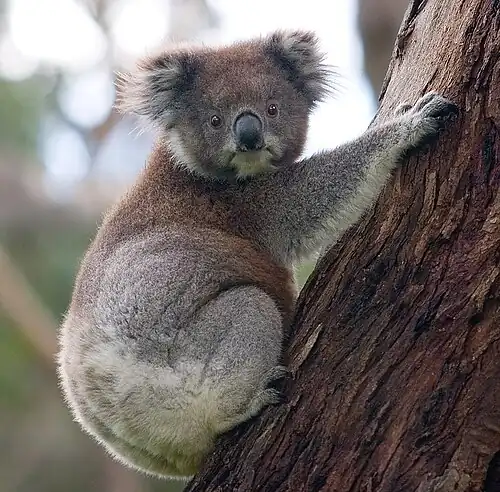
The koala is found in coastal regions of eastern and southern Australia, from near Adelaide to the southern part of Cape York Peninsula. Populations also extend for considerable distances inland in regions with enough moisture to support suitable woodlands. The koala is the national animal emblem of New South Wales.
Related portals
WikiProjects
| WikiProject New South Wales | WikiProject Australia |
Selected articles -
-
![Image 1 The COVID-19 pandemic in New South Wales, Australia was part of the worldwide pandemic of the coronavirus disease 2019 (COVID-19) caused by severe acute respiratory syndrome coronavirus 2 (SARS-CoV-2). The first confirmed case in New South Wales was identified on 19 January 2020 in Sydney where three travellers returning from Wuhan, Hubei, China, tested positive for the virus. As of 1 April 2022[update], there had been over 1,863,186 confirmed cases in NSW: 1,149,142 confirmed cases from PCR testing, and nearly 714,044 positive rapid antigen tests (RAT) since mid-January 2022. 17,509,209 vaccines have been administered. (Full article...)](./_assets_/Blank.png) Image 1The COVID-19 pandemic in New South Wales, Australia was part of the worldwide pandemic of the coronavirus disease 2019 (COVID-19) caused by severe acute respiratory syndrome coronavirus 2 (SARS-CoV-2). The first confirmed case in New South Wales was identified on 19 January 2020 in Sydney where three travellers returning from Wuhan, Hubei, China, tested positive for the virus.
Image 1The COVID-19 pandemic in New South Wales, Australia was part of the worldwide pandemic of the coronavirus disease 2019 (COVID-19) caused by severe acute respiratory syndrome coronavirus 2 (SARS-CoV-2). The first confirmed case in New South Wales was identified on 19 January 2020 in Sydney where three travellers returning from Wuhan, Hubei, China, tested positive for the virus.
As of 1 April 2022, there had been over 1,863,186 confirmed cases in NSW: 1,149,142 confirmed cases from PCR testing, and nearly 714,044 positive rapid antigen tests (RAT) since mid-January 2022. 17,509,209 vaccines have been administered. (Full article...) -
 Image 2Wollongong (/ˈwʊlənɡɒŋ/ WUUL-ən-gong; Dharawal: Woolyungah) is a city located in the Illawarra region of New South Wales, Australia. The name is believed to originate from the Dharawal language, meaning either 'five islands/clouds', 'ground near water' or 'sound of the sea'. Wollongong lies on the narrow coastal strip between the Illawarra Escarpment and the Pacific Ocean, 85 kilometres (53 miles) south of Sydney. Wollongong had an estimated urban population of 302,739 at June 2018, making it the third-largest city in New South Wales after Sydney and Newcastle and the tenth-largest city in Australia by population. The city's current Lord Mayor is Tania Brown who was elected in 2024.
Image 2Wollongong (/ˈwʊlənɡɒŋ/ WUUL-ən-gong; Dharawal: Woolyungah) is a city located in the Illawarra region of New South Wales, Australia. The name is believed to originate from the Dharawal language, meaning either 'five islands/clouds', 'ground near water' or 'sound of the sea'. Wollongong lies on the narrow coastal strip between the Illawarra Escarpment and the Pacific Ocean, 85 kilometres (53 miles) south of Sydney. Wollongong had an estimated urban population of 302,739 at June 2018, making it the third-largest city in New South Wales after Sydney and Newcastle and the tenth-largest city in Australia by population. The city's current Lord Mayor is Tania Brown who was elected in 2024.
The Wollongong area extends from Helensburgh in the north to Windang and Yallah in the south. Geologically, the city is located in the south-eastern part of the Sydney basin, which extends from Newcastle to Nowra. (Full article...) -
 Image 3
Image 3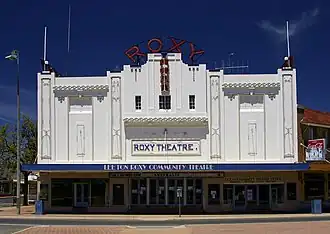 Roxy Community Theatre
Roxy Community Theatre
The Roxy Community Theatre is a heritage-listed cinema, live theatre, theatre, concert venue and meeting venue located at 114-118 Pine Avenue, Leeton in the Leeton Shire local government area of New South Wales, Australia. It was designed by Kaberry and Chard architects in the Art Deco/Art Nouveau/Spanish Mission style and built from 1929 to 1930 by W. H. Hones for George Conson. It is also known as Roxy Theatre and Big Red. The property is owned by Leeton Shire Council. It was added to the New South Wales State Heritage Register on 24 February 2006. (Full article...) -
 Image 4
Image 4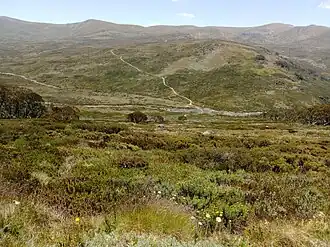 A view of the Main Range and the Snowy River, near Charlotte's Pass
A view of the Main Range and the Snowy River, near Charlotte's Pass
The Kosciuszko National Park (/ˌkɒziˈʌskoʊ/ KOZ-ee-USK-oh) is a 6,900-square-kilometre (2,700 sq mi) national park and contains mainland Australia's highest peak, Mount Kosciuszko, for which it is named, and Cabramurra, the highest town in Australia. Its borders contain a mix of rugged mountains and wilderness, characterised by an alpine climate, which makes it popular with recreational skiers and bushwalkers.
The park is located in the southeastern corner of New South Wales, 354 km (220 mi) southwest of Sydney, and is contiguous with the Alpine National Park in Victoria to the south, and the Namadgi National Park in the Australian Capital Territory to the northeast. The larger towns of Cooma, Tumut and Jindabyne lie just outside and service the park. (Full article...) -
 Image 5The Molonglo Observatory Synthesis Telescope (MOST) is a radio telescope operating at 843 MHz. It is operated by the School of Physics of the University of Sydney. The telescope is located in Hoskinstown, near the Molonglo River and Canberra, and was constructed by modification of the east–west arm of the former Molonglo Cross Telescope, a larger version of the Mills Cross Telescope. Construction of the original "Super Cross" telescope with 1.6-kilometre arms began in 1960 by Professor Bernard Y. Mills. It became operational in 1967. (Full article...)
Image 5The Molonglo Observatory Synthesis Telescope (MOST) is a radio telescope operating at 843 MHz. It is operated by the School of Physics of the University of Sydney. The telescope is located in Hoskinstown, near the Molonglo River and Canberra, and was constructed by modification of the east–west arm of the former Molonglo Cross Telescope, a larger version of the Mills Cross Telescope. Construction of the original "Super Cross" telescope with 1.6-kilometre arms began in 1960 by Professor Bernard Y. Mills. It became operational in 1967. (Full article...) -
 Image 6
Image 6.jpg) Participants in 2012
Participants in 2012
The Sydney Gay and Lesbian Mardi Gras or Sydney Mardi Gras is an event in Sydney, New South Wales attended by hundreds of thousands of people from around Australia and overseas. One of the largest LGBT festivals in the world, Mardi Gras is the largest Pride event in Oceania. It includes a variety of events such as the Sydney Mardi Gras Parade and Party, Bondi Beach Drag Races, Harbour Party, the academic discussion panel Queer Thinking, Mardi Gras Film Festival, as well as Fair Day, which attracts 70,000 people to Victoria Park, Sydney.
The Sydney Gay & Lesbian Mardi Gras is one of Australia's biggest tourist drawcards, with the parade and dance party attracting many international and domestic tourists. It is New South Wales' second-largest annual event in terms of economic impact, generating an annual income of about A$30 million for the state. (Full article...) -
 Image 7
Image 7 Entrance to the Silverwater Correctional Complex
Entrance to the Silverwater Correctional Complex
The Silverwater Correctional Complex, an Australian maximum and minimum security prison complex for males and females, is located in Silverwater, 21 km (13 mi) west of the Sydney central business district in New South Wales, Australia. The complex is operated by Corrective Services NSW, an agency of the New South Wales Government Department of Communities and Justice.
The complex comprises four separate facilities including Silverwater Correctional Centre (a minimum security prison for males); Silverwater Women's Correctional Centre (a maximum security institution for women and the major reception centre for female offenders in NSW); the Metropolitan Remand & Reception Centre (a maximum security correctional facility for males); and the Dawn de Loas Correctional Centre (a minimum security correctional centre for males). (Full article...) -
 Image 8
Image 8 The view from Mobbs Hill has been a noted feature of the district for generations
The view from Mobbs Hill has been a noted feature of the district for generations
Carlingford (/ˈkɑːrlɪŋfərd/) is a suburb of Sydney, in the state of New South Wales, Australia. Carlingford is 22 kilometres (14 mi) north-west of the Sydney central business district in the local government area of City of Parramatta. Carlingford sits at the meeting point of Northern Sydney and Western Sydney sitting on both sides of Pennant Hills Road which generally acts as a divider of the two regions. While being part of City of Parramatta, it is sometimes referred to as being part of the Hills District. (Full article...) -
 Image 9Vista of Lake Keepit at 100% capacity, 2012.
Image 9Vista of Lake Keepit at 100% capacity, 2012.
Keepit Dam is a major gated mass concrete gravity dam with an earth fill abutment and a central gated concrete overflow crest and six radial gate spillways across the Namoi River upstream of its junction with the Peel River in the North West Slopes region of New South Wales, Australia. The dam's purpose includes flood mitigation, hydro-power, irrigation, water supply and conservation. The impounded reservoir is called Lake Keepit. (Full article...) -
 Image 10
Image 10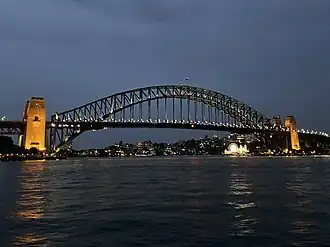 Sydney Harbour Bridge in the evening
Sydney Harbour Bridge in the evening
The Sydney Harbour Bridge is a steel through arch bridge in Sydney, New South Wales, Australia, spanning Sydney Harbour from the central business district (CBD) to the North Shore. The view of the bridge, the Harbour, and the nearby Sydney Opera House is widely regarded as an iconic image of Sydney, and of Australia itself. Nicknamed "the Coathanger" because of its arch-based design, the bridge carries rail, vehicular, bicycle and pedestrian traffic.
Under the direction of John Bradfield of the New South Wales Department of Public Works, the bridge was designed and built by British firm Dorman Long of Middlesbrough, and opened in 1932. The bridge's general design, which Bradfield tasked the NSW Department of Public Works with producing, was a rough copy of the Hell Gate Bridge in New York City. The design chosen from the tender responses was original work created by Dorman Long, who leveraged some of the design from its own Tyne Bridge. (Full article...) -
 Image 11Montreal Community Theatre, pictured in 2010
Image 11Montreal Community Theatre, pictured in 2010
The Montreal Community Theatre is a heritage-listed cinema and community theatre at 46 Russell Street, Tumut, Snowy Valleys Council, New South Wales, Australia. It was designed by Kaberry & Chard and built from 1929 to 1930. It is also known as Montreal Community Theatre and Moveable Heritage Collection. The property is owned by the Snowy Valleys Council. It was added to the New South Wales State Heritage Register on 21 June 2013. (Full article...) -
 Image 12
Image 12 Official logo
Official logo
The Sydney Opera House is a multi-venue performing arts centre in Sydney, New South Wales, Australia. Located on the foreshore of Sydney Harbour, it is widely regarded as one of the world's most famous and distinctive buildings, and a masterpiece of 20th-century architecture.
Designed by Danish architect Jørn Utzon and completed by an Australian architectural team headed by Peter Hall, the building was formally opened by Queen Elizabeth II on 20 October 1973, 16 years after Utzon's 1957 selection as winner of an international design competition. The Government of New South Wales, led by the premier, Joseph Cahill, authorised work to begin in 1958 with Utzon directing construction. The government's decision to build Utzon's design is often overshadowed by circumstances that followed, including cost and scheduling overruns as well as the architect's ultimate resignation. (Full article...) -
 Image 13
Image 13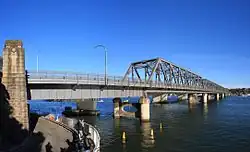 The Pratt truss spans of the 1929 Tom Uglys Bridge, as viewed from the north
The Pratt truss spans of the 1929 Tom Uglys Bridge, as viewed from the north
Tom Uglys Bridge are two road bridges, completed in 1929 and 1987, that carry the Princes Highway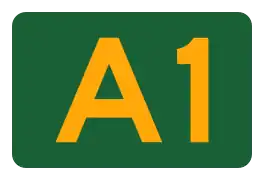 across the Georges River in southern Sydney, in the state of New South Wales, Australia. The bridges link the St George area at Blakehurst to the Sutherland Shire at Sylvania. Tom Uglys Bridge is one of six major road crossings of Georges River.
across the Georges River in southern Sydney, in the state of New South Wales, Australia. The bridges link the St George area at Blakehurst to the Sutherland Shire at Sylvania. Tom Uglys Bridge is one of six major road crossings of Georges River.
The 1929 Pratt truss bridge is listed on the New South Wales State Heritage Register and carries three lanes of northbound vehicular traffic on the Princes Highway. The 1987 concrete box girder bridge was built to the east of the older bridge and carries the three southbound lanes of the highway. Both bridges have shared bicycle and pedestrian pathways. (Full article...) -
 Image 14
Image 14
Sydney Kingsford Smith Airport (IATA: SYD, ICAO: YSSY) — colloquially Kingsford Smith Airport, Sydney Airport or Mascot Airport — is an international airport serving Sydney, New South Wales, Australia, 8 km (5.0 mi) south of the Sydney central business district, in the suburb of Mascot. It is the primary airport serving Sydney and is the main hub for Qantas, the flagship airline of Australia, as well as a hub for Virgin Australia and an operating base for Jetstar.
Situated next to Botany Bay on 907 hectares (2,241 acres) of land with three runways, Sydney Airport is one of the world's longest continuously operated commercial airports and is the busiest airport in Australia, handling 41.4 million passengers and 348,904 aircraft movements in 2024 and 2017, respectively. Currently, 46 domestic and 43 international destinations are served to Sydney directly, having been the 48th busiest airport in the world in 2022. In 2018, the airport was rated in the top five worldwide for airports handling 40–50 million passengers annually and was overall voted the 20th best airport in the world at the Skytrax World Airport Awards. (Full article...) -
 Image 15
Image 15
Sydney (/ˈsɪdni/ ⓘ SID-nee) is the capital city of the state of New South Wales and the most populous city in Australia. Located on Australia's east coast, the metropolis surrounds Sydney Harbour and extends about 80 km (50 mi) from the Pacific Ocean in the east to the Blue Mountains in the west, and about 80 km (50 mi) from Ku-ring-gai Chase National Park and the Hawkesbury River in the north and north-west, to the Royal National Park and Macarthur in the south and south-west. Greater Sydney consists of 658 suburbs, spread across 33 local government areas. Residents of the city are colloquially known as "Sydneysiders". The estimated population in June 2024 was 5,557,233, which is about 66% of the state's population. The city's nicknames include the Emerald City and the Harbour City.
There is evidence that Aboriginal Australians inhabited the Greater Sydney region at least 30,000 years ago, and their engravings and cultural sites are common. The traditional custodians of the land on which modern Sydney stands are the clans of the Darug, Dharawal and Eora. During his first Pacific voyage in 1770, James Cook charted the eastern coast of Australia, making landfall at Botany Bay. In 1788, the First Fleet of convicts, led by Arthur Phillip, founded Sydney as a British penal colony, the first European settlement in Australia. After World War II, Sydney experienced mass migration and by 2021 over 40 per cent of the population was born overseas. Foreign countries of birth with the greatest representation are mainland China, India, the United Kingdom, Vietnam and the Philippines. (Full article...)
Did you know (auto-generated)

- ... that the jury of matrons who assessed whether Ann Davis was pregnant after she was sentenced to death were the first civilian jurors for a criminal trial in New South Wales?
- ... that Robert Brodribb Hammond established the Sydney suburb of Hammondville to house families made homeless by the Great Depression?
- ... that Turkish international soccer player Rojin Polat was named member of the "2021 All Schools Merit Girls Team" in New South Wales, Australia?
- ... that the rural village of Neath, New South Wales, had a population of three Tok Pisin speakers in 2021?
- ... that in its two years of existence, the Hunter River Railway Company initiated construction on what would eventually become the Great Northern Railway connecting Sydney to Queensland?
- ... that many an Xplorer has traversed the rails in Canberra?
General images -
-
.jpg) Image 1Dry paddocks in the Riverina region during the 2007 drought (from History of New South Wales)
Image 1Dry paddocks in the Riverina region during the 2007 drought (from History of New South Wales) -
-
 Image 3A bulk carrier entering the Port of Newcastle, New South Wales, 2009 (from Economy of New South Wales)
Image 3A bulk carrier entering the Port of Newcastle, New South Wales, 2009 (from Economy of New South Wales) -
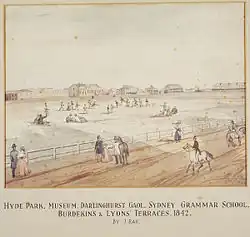 Image 4Hyde Park, Sydney with the Australian Museum under construction in the distance, 1842 (from History of New South Wales)
Image 4Hyde Park, Sydney with the Australian Museum under construction in the distance, 1842 (from History of New South Wales) -

-
 Image 6Founding of the settlement of Port Jackson at Botany Bay in New South Wales in 1788, by Thomas Gosse (from History of New South Wales)
Image 6Founding of the settlement of Port Jackson at Botany Bay in New South Wales in 1788, by Thomas Gosse (from History of New South Wales) -
 Image 7A chart of part of the interior of New South Wales by John Oxley, Surveyor General, 1822 (from History of New South Wales)
Image 7A chart of part of the interior of New South Wales by John Oxley, Surveyor General, 1822 (from History of New South Wales) -
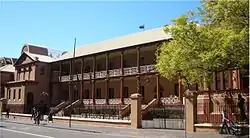 Image 8The New South Wales Parliament is Australia's oldest parliament. (from History of New South Wales)
Image 8The New South Wales Parliament is Australia's oldest parliament. (from History of New South Wales) -
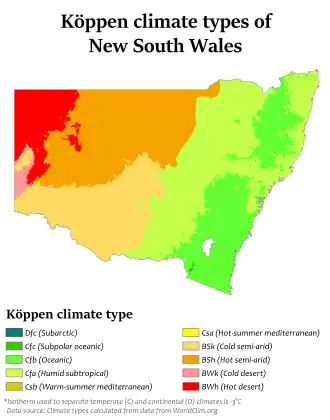
-
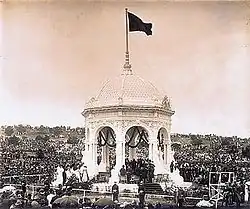 Image 10Federation Pavilion, Centennial Park, Sydney, 1 January 1901. (from History of New South Wales)
Image 10Federation Pavilion, Centennial Park, Sydney, 1 January 1901. (from History of New South Wales) -
 Image 11World leaders with Prime Minister John Howard in Sydney for the 2007 APEC conference (from History of New South Wales)
Image 11World leaders with Prime Minister John Howard in Sydney for the 2007 APEC conference (from History of New South Wales) -

-
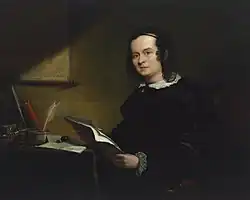 Image 13Humanitarian Caroline Chisholm provided support to poverty-stricken women migrants (from History of New South Wales)
Image 13Humanitarian Caroline Chisholm provided support to poverty-stricken women migrants (from History of New South Wales) -
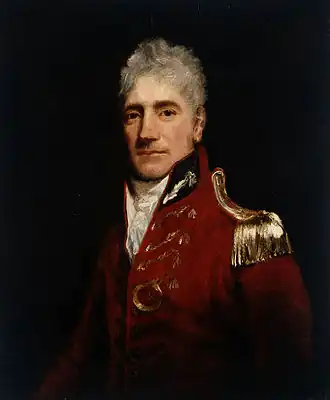 Image 14The 5th Governor of New South Wales, Lachlan Macquarie, was influential in establishing civil society in Australia (from History of New South Wales)
Image 14The 5th Governor of New South Wales, Lachlan Macquarie, was influential in establishing civil society in Australia (from History of New South Wales) -
 Image 15Tumut 3 Power Station was constructed as part of the vast Snowy Mountains Scheme in New South Wales (1949–1974). Construction necessitated the expansion of Australia's immigration program. (from History of New South Wales)
Image 15Tumut 3 Power Station was constructed as part of the vast Snowy Mountains Scheme in New South Wales (1949–1974). Construction necessitated the expansion of Australia's immigration program. (from History of New South Wales) -
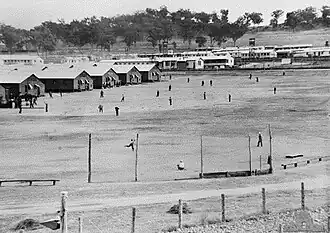 Image 16Japanese POW camp at Cowra, shortly before the Cowra breakout (from History of New South Wales)
Image 16Japanese POW camp at Cowra, shortly before the Cowra breakout (from History of New South Wales) -

-
.jpg) Image 18Landing of Lieutenant James Cook at Botany Bay, 29 April 1770, by E. Phillips Fox (from History of New South Wales)
Image 18Landing of Lieutenant James Cook at Botany Bay, 29 April 1770, by E. Phillips Fox (from History of New South Wales) -
 Image 19A General Chart of New Holland including New South Wales & Botany Bay with The Adjacent Countries and New Discovered Lands, published in An Historical Narrative of the Discovery of New Holland and New South Wales, London, Fielding and Stockdale, November 1786 (from History of New South Wales)
Image 19A General Chart of New Holland including New South Wales & Botany Bay with The Adjacent Countries and New Discovered Lands, published in An Historical Narrative of the Discovery of New Holland and New South Wales, London, Fielding and Stockdale, November 1786 (from History of New South Wales) -
.jpg) Image 20William Wentworth was key in the establishment of self-governance in New South Wales (from History of New South Wales)
Image 20William Wentworth was key in the establishment of self-governance in New South Wales (from History of New South Wales) -
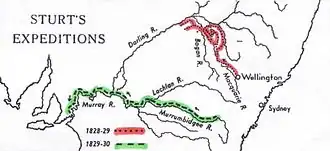
-
 Image 22Mr E.H. Hargraves, The Gold Discoverer of Australia, returning the salute of the gold miners - Thomas Tyrwhitt Balcombe, 1851 (from History of New South Wales)
Image 22Mr E.H. Hargraves, The Gold Discoverer of Australia, returning the salute of the gold miners - Thomas Tyrwhitt Balcombe, 1851 (from History of New South Wales) -
 Image 23Olympic colours on the Sydney Harbour Bridge in the year 2000 (from History of New South Wales)
Image 23Olympic colours on the Sydney Harbour Bridge in the year 2000 (from History of New South Wales) -

-
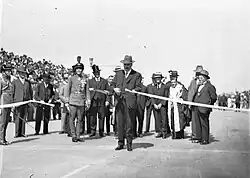 Image 25Ribbon ceremony to open the Sydney Harbour Bridge on 20 March 1932. Breaking protocol, the soon to be dismissed Premier Jack Lang cuts the ribbon while Governor Philip Game looks on. (from History of New South Wales)
Image 25Ribbon ceremony to open the Sydney Harbour Bridge on 20 March 1932. Breaking protocol, the soon to be dismissed Premier Jack Lang cuts the ribbon while Governor Philip Game looks on. (from History of New South Wales) -
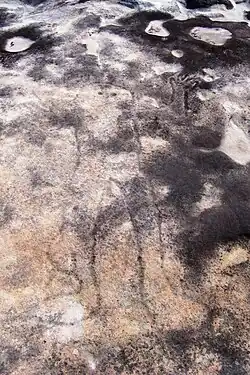
Topics
Categories

More portals
In the news
- 12 August 2025 –
- Red Bull GmbH finalizes the complete acquisition of the Newcastle Falcons rugby union club as its newest venture into another sport, following involvement in football, ice hockey, Formula One, and esports. (AP)
Associated Wikimedia
The following Wikimedia Foundation sister projects provide more on this subject:
-
Commons
Free media repository -
Wikibooks
Free textbooks and manuals -
Wikidata
Free knowledge base -
Wikinews
Free-content news -
Wikiquote
Collection of quotations -
Wikisource
Free-content library -
Wikiversity
Free learning tools -
Wikivoyage
Free travel guide -
Wiktionary
Dictionary and thesaurus
-
 List of all portals
List of all portals -

-

-

-

-

-

-

-

-

-
 Random portal
Random portal -
 WikiProject Portals
WikiProject Portals
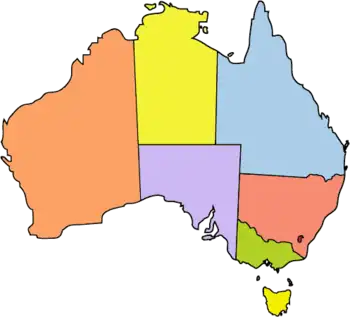
_2019-06-21.jpg)








